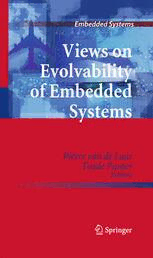
Views on Evolvability of Embedded Systems PDF
Preview Views on Evolvability of Embedded Systems
Embedded Systems SeriesEditors NikilD.Dutt,DepartmentofComputerScience,ZotCode3435,DonaldBren SchoolofInformationandComputerSciences,UniversityofCalifornia,Irvine, CA92697-3435,USA PeterMarwedel,TUDortmund,Informatik12,Otto-Hahn-Str.16,44227 Dortmund,Germany GrantMartin,TensilicaInc.,3255-6ScottBlvd.,SantaClara,CA95054,USA Forfurthervolumes: http://www.springer.com/series/8563 Pie¨rre van de Laar Teade Punter (cid:2) Editors Views on Evolvability of Embedded Systems 123 Editors Pie¨rrevandeLaar TeadePunter EmbeddedSystemsInstitute EmbeddedSystemsInstitute LaplaceBuilding0.10 LaplaceBuilding0.10 DenDolech2 DenDolech2 5612AZEindhoven 5612AZEindhoven Netherlands Netherlands [email protected] [email protected] ISBN978-90-481-9848-1 e-ISBN978-90-481-9849-8 DOI10.1007/978-90-481-9849-8 SpringerDordrechtHeidelbergLondonNewYork LibraryofCongressControlNumber:2010937425 (cid:2)c SpringerScience+BusinessMediaB.V.2011 Nopartofthisworkmaybereproduced,storedinaretrievalsystem,ortransmittedinanyformorby anymeans,electronic,mechanical,photocopying,microfilming,recordingorotherwise,withoutwritten permissionfromthePublisher,withtheexceptionofanymaterialsuppliedspecificallyforthepurpose ofbeingenteredandexecutedonacomputersystem,forexclusiveusebythepurchaserofthework. Coverdesign:SPiPublisherServices Printedonacid-freepaper SpringerispartofSpringerScience+BusinessMedia(www.springer.com) Foreword Back in 2004 new markets in China, India and South America were beginningto openupanditwasimportantforPhilipsHealthcaretomaintainitsstrongpositionin MRImedicalscanners.ForwardthinkingpeopleatPhilipsHealthcareMRIstarted to worry about this and how to remain competitive in an increasingly changing world.Oneoftheproblemswastoeffectivelydealwithaconstantflowofchanges to the system. Thesechangeswere comingin fromall kindsof sources:key tech- nologysuppliers,customer expectations,emergingnew diagnostic techniquesand marketpressurestoreducecost.Foranorganizationdesigningandbuildinghighly complexmedicalimagingsystemsthiswasindeedachallenge. Foranybusiness,stayingaheadrequiresofferinggreatproductsontime andat competitiveprices.ToPhilipsHealthcareMRIevolvabilitymeansthattheimpactof changeshouldbeminimalandpredictable.Forourdevelopmentorganizationthisis akeyenablertodeliveronourcommitments.However,evenseeminglysimplehigh levelchangescanhavearipplingeffectacrossfunctionalboundaries.Wehaveex- periencedinthepasthowunexpectedchangepropagationcanhamperpredictability ofourdevelopments. Designing and building complex products like MRI scanners requires experts frommultipletechnicaldisciplinestoworktogether.Aseachdisciplinehasitsown way of working and its own vocabulary, communication does not always come naturally,raisingtheneedforefficientmeansof communicatingrequirementsand designs. Whileapplyingchangestothesystem,erosionofthequalitiesofthearchitecture hasproventobearealdanger.Ourarchitectswantedsystematicwaystomaintain theintegrityofthesystemarchitecturewhilebeingabletoincorporatechangemore easily.Thereforetheyneededasystemarchitectureanddevelopmentprocessesthat allowforexpectedandunexpectedchange. Oneofourstrategiestoaddressthesekindsofproblemswastoparticipateinthe Darwinproject.AsthenamesuggestsDarwinfocusedonevolvability.Researchers fromESI,PhilipsResearch,theTechnicalUniversitiesofDelft,Twente andEind- hoven,theVUUniversityofAmsterdamandUniversityofGroningencametogether inBesttoworkwithourseniorarchitectstoexplorewaysofmakingchangeeasier andmorepredictable.Thescopeoftheprojectwaswideandcovereddifferentstages oftheproductcreationprocess.Itaddressedverydifferentlevels,fromexposingthe v vi Foreword structure of our rapidly growingcode base, approaching10 million lines of code, tomakingdecisionsonarchitectureevolutionstogetherwithmanagementandtech- nicalstakeholders.We were shownnovelwaysof modelingand visualizationand howthesecanbeusedtoenhancecommunicationandtomoveustowardsa‘right- by-design’wayofworking. This book marks the end of the Darwin project. It contains easy to read de- scriptionsof all the researchcarried outand possible applicationareas. At Philips HealthcareMRIweusedtheDarwinianprinciplestoevaluatetheresultsachieved. Eachresearchtopicwascriticallyevaluatedforsuitabilityandvaluetoourorganiza- tion.Industrialscalepilotswerecarriedoutandonlythefittesttopicswereallowed tobeincorporatedintoourwayofworking.DespitethisharshtreatmentIamhappy to say that significant benefits have been achieved. We have deployed techniques and tools into our organizationthat help us to communicatebetter,to capture and implementourowndesignideasandtopredictandanalyzecomplexsystembehav- ior. Topics thatwere notfoundfit enoughin our setting may verywell flourish in otherenvironments,butofcoursethatisallpartoftheDarwinstory. We are happy with the results achieved by the Darwin project and it has once again demonstrated the benefits to be gained from working with outside groups. The different parties involved in Darwin have provided us with some innovative approaches that can help us maintain our “Best-in-Class” status in MRI system development. April2010 FonsGijselhart VicePresident/DevelopmentandPMOManager MRISystems PhilipsHealthcare Preface Ithasbecomea traditionthateachEmbeddedSystemsInstitute’s5yearIndustry- as-Laboratory project is concluded with a book, bringing together the main achievements of the research. This is now the fifth book in this series. In a way it is also the first book, as this book is published by the international publisher, Springer,asopposedtoourearlierbooks,whichwerepublished‘inhouse’. This book describes the Darwin project which addressed the challenges of designingandmaintaininglargeembeddedsoftware-basedsystems.Theindustrial vehiclechosenfortheresearchwastheMRIscannerfamilymadebyPhilipsHealth- care.MRI scannersarecomplex,high-value,high-endmachinesofferinga unique detailed view of the inside of the human body. In this specialized field Philips is a renownedworldleader.Theprojectteamwasmadeupofresearchersandarchi- tects from the Embedded Systems Institute, Philips Healthcare, Philips Research, TUDelft,TUEindhoven,theUniversityofTwente,theUniversityGroningenand theVUUniversityofAmsterdam.DarwinstartedinOctober2005andranuntilthe endofSeptember2010. The Darwin project focused specifically on system evolvability, that is, a sys- tem’sabilitytohandlechangestoitsrequirements,environmentandimplementation technologies. The need to improve system evolvability is becoming increasingly recognized, especially in the engineering of computer based systems, where the development, commissioning and replacement of large systems can be extremely costly.Despite thisclearindustrialneed,therearenoformalmeansforevaluating the evolvability of systems; hence, no means of proving that one system is more evolvable than another. The Darwin project recognized this and aimed to provide methodsandtoolsthatwouldleadtothedesignofhighlyevolvablesystems.MRI scanners,apartfromthecomplexityoftheirmechanicalandphysicalcomponents, contain close to 10 million lines of code. Time to market pressures, customer de- mands, system opennessand strict certification proceduresall increase a system’s complexity making evolvability an important system quality. The Industry-as- Laboratoryparadigm,pioneeredbyESI,bringstogetherresearchersfromacademia andindustrytofocusonconcreteindustrialcasesandhasbeeninstrumentalinthis project.Withoutthisapproach,universityresearcherswouldnothavebeenableto validate their work, nor would they have had access to a real system’s code base. vii viii Preface Conversely,theapproachhasallowedindustrialsystemdesignerstoseethemerits ofadvancednewsoftwareandsystemdevelopmenttechniquesbeingdevelopedin academia. I would like to thank all participants in this project for their commitment and contributions; as a team, they have made Darwin into a success! The support of PhilipsHealthcareandtheDutchMinistryofEconomicAffairs(AgentschapNL), whoprovidedthefinancialsupport,viatheBSIKfunding,forDarwin,aregratefully acknowledged.We also thank Springer for their willingness to publish this book. Withthisbook,theEmbeddedSystemsInstitutehopestosharethemostimportant results and insights of the Darwin projectwith a wider audience,both in industry andacademia. April2010 Prof.dr.ir.BoudewijnHaverkort ScientificDirector&Chair EmbeddedSystemsInstitute TheNetherlands Acknowledgements This work has been carried out as a part of the DARWIN project at Philips HealthcareundertheresponsibilitiesoftheEmbeddedSystemsInstitute(ESI).This projectispartiallysupportedbytheDutchMinistryofEconomicAffairsunderthe BSIK program.We gratefullyacknowledgethe inputfrommanypeopleatPhilips Healthcare MRI over the five years of the Darwin project. Special thanks go to Philips Healthcare for organizingan Industry-as-Laboratoryproject in their com- pany. We also thank the Philips Healthcare and Philips Research employees, our academicpartnersandourESIcolleaguesthatwereinvolvedforreviewingthechap- ters. Their peer reviews provided constructive feedback and improved the quality of the book. Furthermore, we like to thank our academic partners (University of Twente,EindhovenUniversityofTechnology,VU UniversityofAmsterdam,Uni- versity of Groningen and Delft University of Technology), Philips Research and Philips Healthcare for writing a variety of book chapters. This has resulted in a bookthatshowstheviewsonevolvabilityofembeddedsystems. ix
